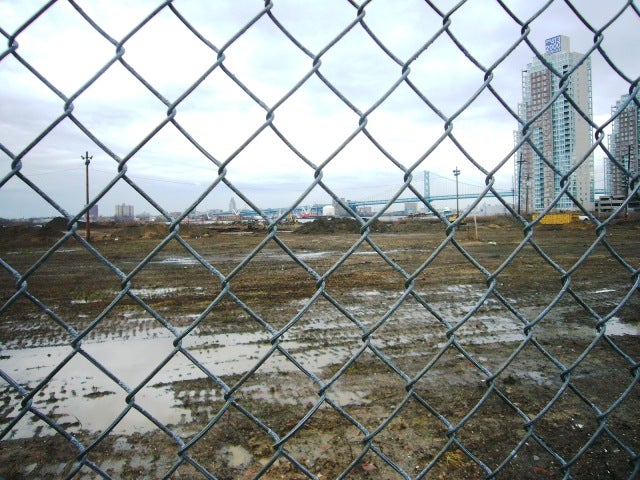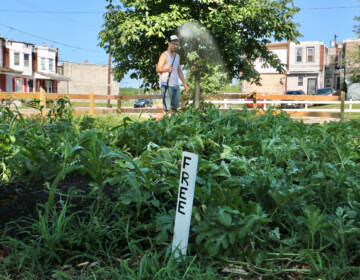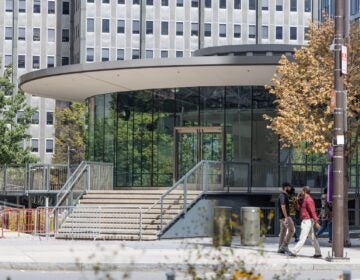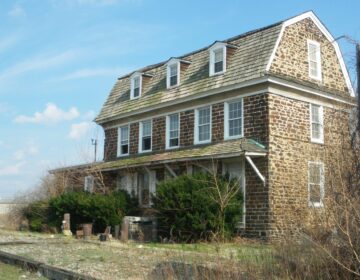SugarHouse work could go to Phase III

Feb. 19
By Kellie Patrick Gates
For PlanPhilly
The chances of finding artifacts from the British occupation of Philadelphia is too remote to delay construction on the SugarHouse Casino site, the casino’s archaeology consultant says in a recent report.
While A.D. Marble recommends more archaeological digging on a small portion of the site where Native American artifacts were discovered, the Conshohocken firm says there is little point in further searching for evidence of a British fort and barracks, because they were destroyed long ago.
Marble also tells the SugarHouse concern that the Army Corps of Engineers and the Pennsylvania Historic and Museum Commission — both involved with the ongoing, federally mandated historic review of the Delaware Avenue site — may request another round of searching for the Fort to appease a group of local historians and history buffs. “Such requests may be necessary to ensure that enough positive or negative evidence has been gathered and analyzed to help review agencies reach the conclusion that the investigation/evaluation portion of this cultural resource study is complete,” Marble wrote in its three-inch-thick report.
Should that happen, Marble suggests that archaeologists watch as the Belgian block of Penn Street and the water and sewer lines buried beneath it are removed and the “below ground construction” of the casino east of Penn Street takes place.
“Geo-referenced mapping suggests that the central portion of the 1777 Redoubt No. 1 was likely situated in line with this street,” Marble wrote. Archaeology via this monitoring procedure would be “a cost savings measure,” the company says. “Recordation of any historic resources would be carried out as the excavation progressed and work would be halted if necessary to examine potentially significant cultural resources.”
This approach would both ensure the “proper treatment of resources” within the guidelines of the federal law, and save the casino from “conduct(ing) very deep excavations twice in the same area.”
SugarHouse spokeswoman Leigh Whitaker said the casino can’t start digging under the street until it gets permission from the water and sewer departments to cap off their lines. “We’re prepared to do further exploration as recommended by A.D. Marble – during the construction period,” she said.
Calls for more archaeology
Marble is right in anticipating that the consulting parties would want more digging to find the Fort. “They are clearly going to have to do more work out there,” said Douglas Mooney, the archaeologist who was field director of the President’s House dig and is president of the Philadelphia Architectural Forum.
Mooney disagrees with the reasons Marble gives for not expecting to find anything. But he’s happy with the procedure they suggest should SugarHouse be required to look some more.
“What they are actually proposing is a fairly robust effort to try to say is the fort here or is it not,” he said.
Not everyone is satisfied that watching out for historic artifacts during construction will safeguard the past. That’s not good enough for a fort that played a role in the American Revolution, said Torben Jenk, a preservationist and local historian from Kensington.
“A fort from the war that founded this nation, where people died. That’s not important?” he asked. “What’s so fascinating about Fort No. 1 is that it was manned by the Loyalists – folks who were loyal to the Crown. They were Americans fighting against independence.”
Jenk not only wants more digging, he wants it to be overseen by a firm other than A.D. Marble.
Marble’s first archaeological report did not mention the fort. This shocked Jenk and others, because before actual excavation, archaeologists dig through historic evidence to learn what they might find on the site. Jenk sent information to Marble, PHMC and the Army Corps, and in its next report, Marble said they had subsequently learned about the fort.
“Is it believable that these people are looking (for artifacts from the fort) or is there some other factor at play?” Jenk asks.
SugarHouse has no plans to switch archaeology firms, said spokeswoman Leigh Whitaker. “We’re sticking with them,” she said. “We are confident they are doing everything professionally, appropriately and with integrity.” Whitaker said archaeological investigations are Marble’s business, and they would never do anything to jeopardize their reputation, since they will be in business long after the casino issue is resolved.
Marble’s report is a piece of a historical review required because SugarHouse needs a permit to build into the Delaware River. The Army Corps of Engineers grants the permit, but it takes advice regarding historic preservation from the Pennsylvania Historical and Museum Commission. (It also weighs environmental and other factors that are not history related). The Corps considers the opinions of the interested groups and individuals who applied to be part of the process. These consulting parties received copies of the latest Marble report, which details the findings of the second phase of digging and research, by mail late last week and today. The Corps wants all comments from these consulting parties by the end of February, and will soon announce the start of a 30-day public comment period. No decision will be made at least until the public comment period is over, a Corps spokesman said.
Marble’s report says that much of the fort was likely destroyed in the years following the revolution. While the walls were made of dirt, many other portions of the fort were wooden. After the war, wood was scarce, so Philadelphians scavenged what they could, the report states.
But Jenk said portions of the fort and related structures may have been made of stone, since the British forces had hundreds of masons in their employ. And Philadelphians desperate for lumber likely did not dig up a stockade that sank into the muck and ran down to the river.
Marble says that whatever Philadelphians didn’t repurpose was destroyed by later construction – particularly that of an industrial nature.
“West of Penn Street, the excavation of basements and foundations for nineteenth- and twentieth-century buildings has taken place throughout the general redoubt location,” the report states. “Massive truncation of the original land surface took place in the later nineteenth century to construct the rail yard of the Shackamaxon freight station.
“If not completely demolished within the early nineteenth century, the former berms that formed the redoubt walls were undoubtedly removed during later demolition of the rail yard and the subsequent regarding of the property.”
East of Penn Street, it’s even worse, archeologically speaking, said Marble “with the construction of the massive building for the Pennsylvania sugar refinery.”
Marble says archeologists stripped the land on either side of Penn Street, looking for fort-related artifacts. And what they found was “deep disturbance and demolition of twentieth-century buildings to a depth of 9 to 13 feet below the present surface – a depth likely well below the grade of the redoubt.”
None of this assures Jenk, either. That’s not disturbed original land that Marble found, but fill placed on top of it, he said. Jenk said archeologists need to dig deeper – and also further toward the river, as soldiers and other people likely left items behind around the fort, not just within it.
The report says the only place anything could possibly be left would be beneath the street. But even beneath the street, “several utility lines run below and under Penn Street and have likely caused some degree of damage to any possibly remaining archaeological deposits associated with the redoubt.”
But Mooney said streets are often like big, protective blankets for artifacts. As an archaeologist, he loves digging under them.
“There were utilities, but those tend to be pretty limited disturbances,” he said.
In written comments submitted to the Army Corps, Mooney writes that while Marble presumes “construction of the street and associated utilities probably removed any traces of the fort that might have once been there, such assumptions are not supported by evidence from this and other sites in the city. To the contrary, findings from other archaeological investigations in Philadelphia have repeatedly demonstrated that the construction of streets frequently serves to enhance the preservation of archaeological deposits, and that utility installation tends to result in comparatively localized disturbances.”
Mooney thinks Marble has done a good job when it has looked for something, but he is puzzled by some things for which the company seems to have not looked.
“Philadelphia has lived and died by its seaport,” he said. He knows of only two archeological investigations on the waterfront, and intact wooden wharves and other “remarkable” artifacts were found. “This would have been a prime example to go after – the 18th and 19th Century Waterfront in Fishtown,” he said.
Many Native American artifacts
While none of the digging done on the Delaware Avenue site so far has unearthed anything related to the fort, the investigation has yielded more than 4,000 historic artifacts – mostly pottery shards and bottles from the 18th and 19th centuries, but more than 200 Native American artifacts.
Marble recommends further digging in six shaft features – wells and privies – and within a 50-by-30 foot area where Native American artifacts were found. Marble says that this small site was within the only area of land on the site that has been largely undisturbed.
One found projectile point, commonly called an arrowhead – has characteristics of point styles used in about 1500 B.C., Marble wrote. Other artifacts included shards of rock left over from making projectiles and charred and cracked rocks that were used around a fire for heat or cooking.
“None of the fire-altered rock made any pattern suggesting an intact hearth feature,” Marble wrote. “No living floors were uncovered.”
Marble says that based on what was found and what was not found, “the Native American site represents a short-term occupation that included activities related to tool manufacture, low-scale resource processing, and the building of hearths related to produce heat for warmth and/or cooking.”
Regionally, such a site is common. But “given the exceedingly low amount of sites found within the city limits of Philadelphia, the identification of this Native American site becomes very important within the context of the precontact record within Philadelphia’s boundaries. The information that could be contained in this small site would likely be a significant contribution to the understanding of precontact activities dating to times well before Native American contact with European explorers and settlers.”
The Delaware Indians were long ago pushed out of this area and the Delaware Nation is now headquartered in Oklahoma.
Tamara Francis, the Nation’s cultural preservation director, was recently added to the list of consulting parties on the SugarHouse case. She said she could not speak with PlanPhilly until she received an okay from the Nation’s president.
Local historians say that one meaning for the name Shackamaxon is “meeting place of the chiefs” and it is likely that leaders of various tribes gathered at or near the SugarHouse site because the Delaware and its tributaries made it an easy place to travel to by canoe.
One of the consulting parties, John Connors, is director of the Penn Treaty Museum. Penn Treaty Park, thought to be the site where William Penn signed a treaty of friendship with Native Americans, is adjacent to the site. And the diary of Lt. Simcoe – commander of the soldiers at the Fort – shows that he stationed guards around the large tree where the treaty was signed, to protect it against anyone who might see it as a source of firewood.
Mooney noted that Marble’s recommendation to dig more in search of Native American artifacts was a reversal from the preliminary phase two report it issued last month.
“We absolutely agree” that this is the right thing to do, he said.
Contact the reporter at kelliespatrick@gmail.com
WHYY is your source for fact-based, in-depth journalism and information. As a nonprofit organization, we rely on financial support from readers like you. Please give today.






